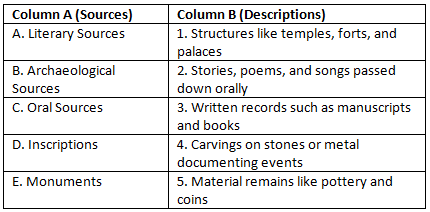Worksheet with Solutions: Places of Eminence | Footprints Class 7: Book Solutions, Notes & Worksheets PDF Download
| Table of contents |

|
| Multiple Choice Questions (MCQs) |

|
| Fill in the Blanks |

|
| True or False |

|
| Match the Following |

|
Multiple Choice Questions (MCQs)
Q1: What is the primary focus of history?
(a) Studying future events
(b) Exploring present circumstances
(c) Investigating past events
(d) Predicting technological advancements
 View Answer
View Answer 
Ans: (c) Investigating past events
Q2: Which type of sources provide clues through stories and legends transmitted orally?
(a) Literary sources
(b) Archaeological sources
(c) Material remains
(d) Oral histories
 View Answer
View Answer 
Ans: (d) Oral histories
Q3: What does the Arthashastra manuscript primarily provide insights into?
(a) Religious practices
(b) Economic and military strategies
(c) Cultural events
(d) Artistic developments
 View Answer
View Answer 
Ans: (b) Economic and military strategies
Q4: Which of the following is NOT considered an archaeological source?
(a) Coins
(b) Pottery
(c) Literary texts
(d) Monuments
 View Answer
View Answer 
Ans: (c) Literary texts
Q5: In which century was the Mudrarakshasa written?
(a) 5th century BCE
(b) 2nd century CE
(c) 10th century CE
(d) 18th century CE
 View Answer
View Answer 
Ans: (b) 2nd century CE
Fill in the Blanks
Q1: Sources that help in reconstructing the past are known as ________ sources.
 View Answer
View Answer 
Ans: Archaeological
Q2: The remains of the past are found in monumental remains, sculptures, art, and __________.
 View Answer
View Answer 
Ans: Stories
Q3: The Indian history spans over __________ years.
 View Answer
View Answer 
Ans: Thousands of
Q4: Literary sources include writings such as books, newspapers, journals, and __________.
 View Answer
View Answer 
Ans: Diaries
Q5: The Arthashastra manuscript provides guidelines on how to run the __________.
 View Answer
View Answer 
Ans: Government
True or False
Q1: Oral histories provide written records of past events. True or False?
 View Answer
View Answer 
Ans: False
Q2: Monumental remains include temples, forts, and palaces. True or False?
 View Answer
View Answer 
Ans: True
Q3: Coins issued by kings or guilds can provide insight into the economic conditions of the time. True or False?
 View Answer
View Answer 
Ans: True
Q4: The Vedas are collections of poems and hymns transmitted orally. True or False?
 View Answer
View Answer 
Ans: True
Q5: Inscriptions do not provide any valuable information about the past. True or False?
 View Answer
View Answer 
Ans: False
Match the Following

 View Answer
View Answer 
Ans:
A → 3 (Literary sources are written records such as manuscripts and books.)
B → 5 (Archaeological sources include material remains like pottery and coins.)
C → 2 (Oral sources are stories, poems, and songs passed down orally.)
D → 4 (Inscriptions are carvings on stones or metal documenting events.)
E → 1 (Monuments are structures like temples, forts, and palaces.)
|
32 videos|247 docs|40 tests
|
FAQs on Worksheet with Solutions: Places of Eminence - Footprints Class 7: Book Solutions, Notes & Worksheets
| 1. What are some examples of places of eminence mentioned in the article? |  |
| 2. How did these places of eminence contribute to the spread of knowledge and learning? |  |
| 3. What role did these places of eminence play in shaping India's intellectual and cultural history? |  |
| 4. How did the decline of these places of eminence impact the field of education in India? |  |
| 5. Are there any efforts being made to revive the glory of these places of eminence in modern times? |  |




















